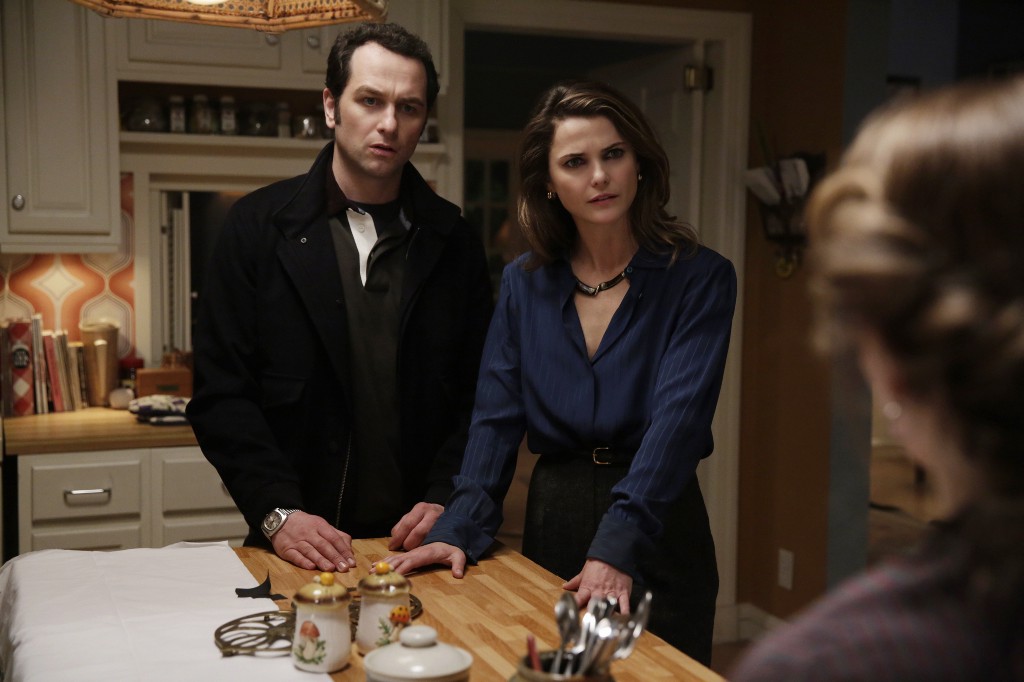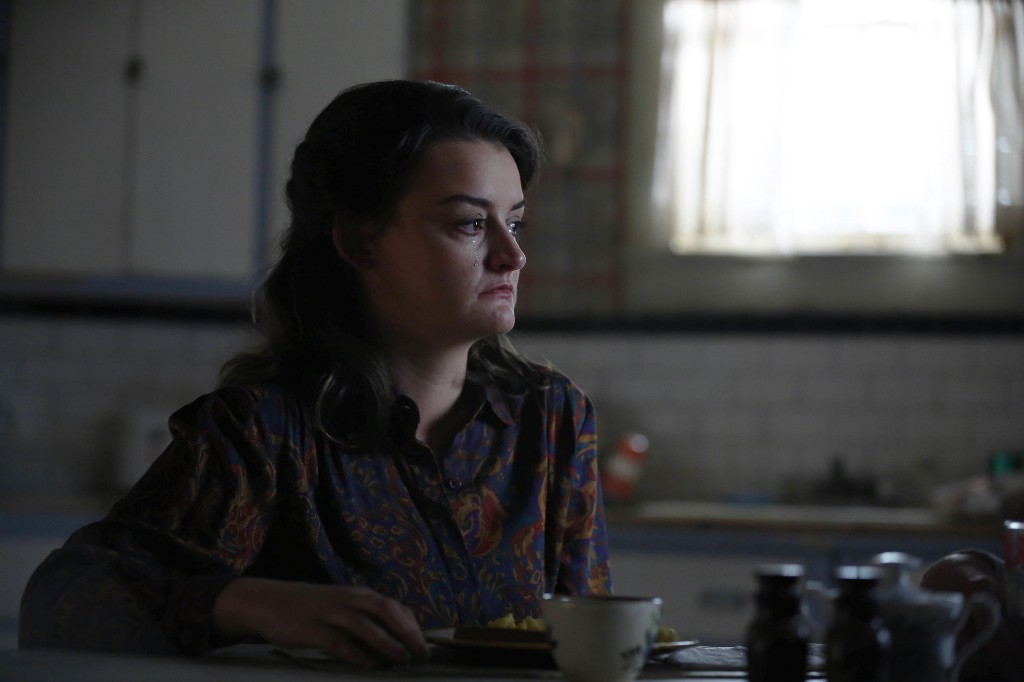House Of Spies
The ambivalent consumption of “The Americans.”

The threat of annihilation has always hung over the characters of “The Americans.” The show’s KGB spies embedded in Reagan-era domestic American life fear being imprisoned or swiftly executed. But in the show’s fourth season, Philip and Elizabeth Jennings and their children, Paige and Henry, learn of other sinister fates, which can come at you through the TV or even the fridge where you keep your six-pack of Miller High Life. (MillerCoors is the official beer sponsor of FX, the show’s network)
In a recent episode, nearly every character on the show paused to watch the 1983 TV movie “The Day After,” which portrays a Soviet nuclear attack on U.S. soil — a couple standing at the altar exchanging marital vows is incinerated into skeletons. Meanwhile, operatives are passing along stolen bioweapons, keeping the vials in their freezers. Philip suggests to Elizabeth that they withhold a new piece of intelligence — a substance American scientists devised that causes blood to ooze from one’s pores. In Elizabeth’s view, Philip has always been soft; willing to let America have something Russia doesn’t. “These are people that dropped the atom bomb — twice,” She says. “We can’t just sit in our comfortable house and pretend.”
It’s clear that the phrase Elizabeth holds in the most contempt is not “atom bomb” but “comfortable house.” While the men in her household are in thrall to the Chevy Camaro and the Commodore 64, and her daughter clings to a Bible and a Trapper Keeper, Elizabeth parrots Karl Marx with utter sincerity: “The production of too many useful things results in too many useless people.” She sees Corningware for the housewife’s triple-threat that it is: A dish that can go from the freezer to the stove without cracking, molded from a substance once found in the nosecones of antiaircraft missiles.

Diane Lederman, who designed the sets for “The Americans,” began by hypothesizing that spies wouldn’t decorate their own homes; she imagined that a separate KGB asset studied American culture and decorated the spaces to blend in accordingly. “There is absolutely an extra effort to furnish the home with whatever Americana you can to make it seem like they’re the average American family,” she said. “We have to take it as far away as possible from anything Russian.”
Lederman’s effort even extends to vintage product labels. She asks brands for the archived art files, so she can faithfully reprint the packaging of Milky Way candy bars, or jars of Jif peanut butter, like the one longed after by an FBI agent about to be extracted to the Soviet Union via Cuba. (For the 2013 Lee Daniels’ film “The Butler,” she commissioned Lenox to refire Nancy Reagan’s china pattern from 1981.)
The peanut-butter gazer, of course, would be Poor Martha, as the internet calls her. Her efficiency apartment had everything the 1980s single lady needed: plenty of wine, the Kama Sutra, a gun. If you had the sense that peering into her home each week made you something like Jimmy Stewart in “Rear Window,” spying on Miss Lonelyhearts, that was intentional, said Lederman.

Back when Martha had her gun, fans were always calling it Chekhov’s. Part of the show’s paranoia is that every object can take on a Chekhovian inevitability. Chekhov’s Crock-Pot will simmer over, Chekhov’s Commodore 64 is transmitting a signal to the FBI, Chekhov’s Twinkie will ultimately explode. The isolating effects of chronic deception is a theme “The Americans” exploits particularly well through its objects. The more things you surround yourself with, the more they can betray you. (As for what Lederman’s sets betray about the rest of the fourth season: for the finale, she designed a communal apartment set in Moscow, seeming to hint we’ll glimpse Poor Martha again.) Only ABC’s “Blackish” rivals “The Americans” in the way its central couple punish themselves for the comforts of designer sneakers and state-of-the-art appliances. Fear of the word “bougie” is the “Blackish” equivalent of the Red Scare.

“The Americans” takes place in the Washington, D.C., suburb of Falls Church, Virginia, one of the country’s wealthiest enclaves. (Most of the exterior filming takes place around Brooklyn.) What marks the Jenningses as Other is their suspiciously small career ambitions (travel agents) and merely ambivalent consumption. Philip and Elizabeth reject the luxuries of time and experience; as of press time they still have not made good on a promise to take Henry and Paige to EPCOT.
The writer Gary Shteyngart’s mother lied to him about family vacations, too. In Little Failure, his memoir of his family’s emigration, in 1979, from Leningrad to Queens, Shteyngart recalls his mother telling him they would be staying at a Hilton during a summer trip to Cape Cod. Instead, they checked into an accommodation with “a toilet that should not really be indoors,” Shteyngart writes.
“My mother is from a country of lies, and I am still one of its citizens,” he writes. “She can lie to me at will. She can lie to me without using her imagination.” Shteyngart’s father, meanwhile, is the soft Philip Jennings to his mother’s hard-line Elizabeth. As an engineer on Ronald Reagan’s “Star Wars” missile-defense program, Shteyngart’s father was someone the Jenningses would have befriended, then betrayed. The author has said on Twitter and Reddit that “The Americans” is his favorite show.
Shteyngart experiences his adopted homeland as a glutton, gorging on TV and the foods Lederman re-creates for “The Americans”: Doritos, Ding Dongs, and frozen pepperoni pizzas. He dreams of mogul-dom, scraping together money to make over his bedroom in the style of J.R. Ewing’s office on “Dallas.” “Whenever I feel blue,” Shteyngart writes, “I stride into my so-called office, grab the expensive phone, and, with what I think is a Texas accent, shout into the receiver, ‘Hi darlin’! You just hang tight, y’hear?’”
That’s sort of the broad humor of memoir, but Shteyngart is sincere about the power we give television to guide our lives as professionals, family members, and consumers. Like the characters of “The Americans,” he, too, is traumatized by the broadcast of “The Day After.” Fearing he might be flash-blinded by a nuclear explosion like a boy in the broadcast, he goes to a department store and buys a nice pair of sunglasses. “The greatest lies of our childhood are about who will keep us safe,” Shteyngart concludes. A close second is the lie about useful things making us happy.
Kyle Brazzel writes about culture and connectedness. He lives in Brooklyn.
